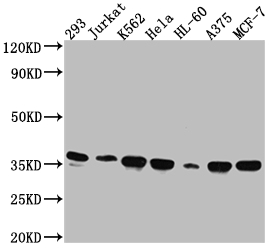STX4 is a t-SNARE that is extensively expressed in numerous tissues, including skeletal muscle, and plays a vital role in glucose absorption in response to insulin in skeletal muscle and adipose tissue by delivering glucose transporter 4 (GLUT4) to the cell membrane. In beta cells, STX4 has also been demonstrated to modulate glucose-stimulated insulin production. It's also involved in cell invasion and invadopodium development, which is linked to the malignant growth of several human malignancies.
The preparation of the recombinant STX4 antibody involves the mammalian cell lines expression of plasma vectors containing STX4 antibody genes. B cells isolated from immunized animals' blood were treated to obtain RNA, which underwent reverse transcription to yield DNA genes. Antibody genes were sequenced and screened from the DNA. After transient expression, cell supernatant was collected and then purified using Affinity-chromatography to obtain the recombinant STX4 antibody. This recombinant STX4 antibody is recommended to use in the STX4 for the detection of STX4 protein from Human.






